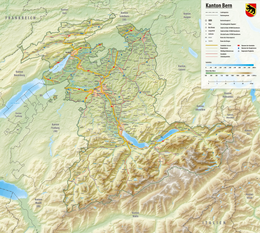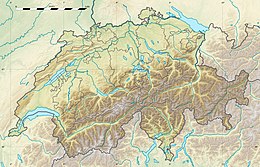 St. Peter's Island as seen from Twann/Douanne St. Peter's Island as seen from Twann/Douanne | |
   | |
| Geography | |
|---|---|
| Location | Lake Biel |
| Coordinates | 47°04′15″N 7°08′33″E / 47.07083°N 7.14250°E / 47.07083; 7.14250 |
| Highest elevation | 474 m (1555 ft) |
| Administration | |
| Switzerland | |
| Canton | Bern |
| Districts | Biel/Bienne Seeland |
St. Peter's Island (French: Île Saint-Pierre; German: Sankt Petersinsel) is a peninsula and former island situated in Lake Biel in the canton of Bern, Switzerland. It has a length of about 5 kilometres (3.1 mi) and a maximum width of 800 metres (2,600 ft). Its highest point is 474 metres (1,555 ft) above sea level or 45 metres (148 ft) above lake level (429 m ). It was formed in the last Ice Age (see Pleistocene), when the Rhône Glacier reached as far as the Jura mountains. It is a promontory of the Jolimont, above Erlach. Politically the island is split between the municipalities of Erlach and Twann-Tüscherz, the largest part belonging to the latter municipality.
In the late nineteenth century, following the engineering works of the Jura water correction, the water-level of the three lakes of the Seeland have dropped enough to clear the until-then hidden isthmus, linking Cerlier to St. Peter's Island, which has ever since become a peninsula, although separated from the shore by a canal.
Monks of the Cluniac order were the first inhabitants of the island, and built a monastery here in 1127.
Before his expulsion, Jean-Jacques Rousseau spent two months on the island in 1765, calling it the "happiest time of his life".
The priory


The former priory building is a listed as Swiss heritage site of national significance. It was founded in 1107 when Count Wilhelm III of Burgundy-Mâcon gave his lands in Bellmund and on the island, at the time known as the "Island of the Counts", to Cluny Abbey. A small monastery was built on the island, possibly on the site of an earlier church. Traces of Merovingian graves, a Carolingian wooden monastery and an abandoned 11th century basilica have been discovered near the current building. The small priory had at most five monks in residence and may have had additional rooms for travelers. On 10 February 1127 Wilhelm IV, the son of Wilhelm III, was buried in the monastery graveyard after he was murdered in Payerne a few days previously. A monastery church was built north of the priory in the first third of the 12th century. The vogt and patronage rights over the monastery remained with the Counts of Burgundy before probably passing to the Zähringens. They were followed by the Counts of Kyburg, in the 13th century and the Counts of Nidau in the first half of the 14th. In 1484 the priory was dissolved and the estates passed to the college of canons of St. Vinzenz Cathedral in Bern. After Bern accepted the Protestant Reformation in 1530, the priory buildings were transferred to the Niederen Spital (a hospital) in Bern. The monastery church was demolished in 1577 and a wine cellar built below the former choir. Over the following years the priory building was used as a sheep farm and an inn and it was extensively modified, renovated and rebuilt. Originally built as a four-sided building with a central courtyard, in 1810/15 the north wing was demolished turning it into a three-wing, horseshoe-shaped building. The south wing was unified under a single roof in the 19th century and in 1911 it was renovated in the Swiss Heimatstil.
Today the priory building is a hotel and restaurant.
References
- "Rousseau's Expulsion from the Ile Saint-Pierre" Edward D. Seeber M.L.N., Vol. 79, No. 5, (December 1964), pp. 539-543
- "Swiss inventory of cultural property of national and regional significance". A-Objects. Federal Office for Cultural Protection (BABS). 1 January 2017. Retrieved 20 November 2018.
- ^ "Protection of cultural property inventory with objects of national importance". api3.geo.admin.ch. Retrieved 2018-11-20.
- ^ St. Peter's Island in German, French and Italian in the online Historical Dictionary of Switzerland.
- ^ "Gemeinde Twann-Tüscherz" (PDF). www.erz.be.ch/erz/de/index/kultur/denkmalpflege.html. Canton of Bern, Office of Cultural Protection. Retrieved 20 November 2018.
- Hotel/Restaurant website
- Swisstopo topographic maps
External links
This Canton of Bern location article is a stub. You can help Misplaced Pages by expanding it. |